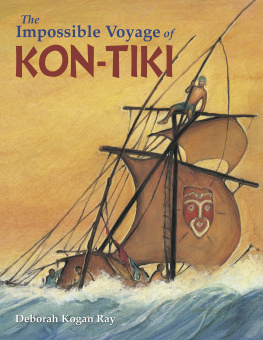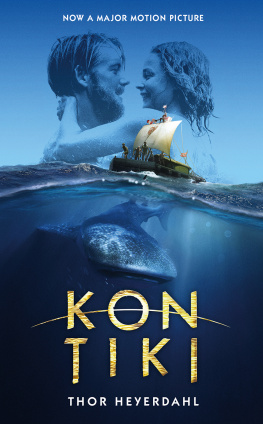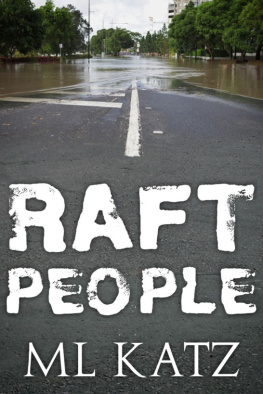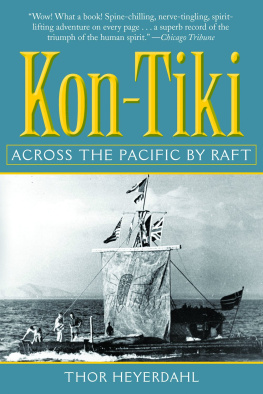FROM RAFT TO RAFT
FROM RAFT TO RAFT
An Incredible Voyage from Tahiti to
Chile and Back
By BENGT DANIELSSON
From the narrative of ALAIN BRUN
Translated from the Swedish by F. H. LYON

Skyhorse Publishing
Copyright 1960 by George Allen & Unwin, Ltd.
Copyright renewed 1988 by George Allen & Unwin, Ltd.
Published by arrangement with Doubleday, an imprint of The Knopf Doubleday Publishing Group, a division of Random House, Inc.
All Rights Reserved. No part of this book may be reproduced in any manner without the express written consent of the publisher, except in the case of brief excerpts in critical reviews or articles. All inquiries should be addressed to Skyhorse Publishing, 307 West 36th Street, 11th Floor, New York, NY 10018.
Skyhorse and Skyhorse Publishing are registered trademarks of Skyhorse Publishing, Inc., a Delaware corporation.
Visit our website at www.skyhorsepublishing.com.
10 9 8 7 6 5 4 3 2 1
Library of Congress Cataloging-in-Publication Data is available on file. ISBN: 978-1-62087-782-1
Printed in the United States of America
CONTENTS
Introduction
AN IMMORTAL SEA ROVER
It was early one morning at the end of October 1956. While most of my fellow-passengers on board the French Pacific Lines ten thousand-tonner Tahitien were still asleep, I hurried up on deck to get the earliest possible sight of the most beautiful island in the world, Tahiti, to which I was now returning for the fifth time. It was still pitch dark, and it was a long time before I could distinguish with difficulty a jagged silhouette to starboard. Were we already so near my longed-for goal? My uncertainty was soon removed, for only a quarter of an hour later the first faint light of dawn revealed that it was the neighbouring island of Moorea I had seen. At the same time, and just as suddenly, the central peaks of Tahiti, more than 7000 feet high, stood out clearly against the quickly lightening sky thirteen miles farther east. The mountains, cleft by erosion, with their many ridges and valleys, were at first as grey and lifeless as a moon landscape, but the nearer we came and the higher the sun rose into the sky, the greener, softer and richer in changing colours they became.
Astonished and delighted to find that the picture I had preserved in my heart during my two years absence had been so faithful a copy of reality, I let my eyes travel round the scene I had known so well, from the historic Matavai Bay to eastward to the bare Cape Tataa in the west, whence, according to an old Tahitian tradition, the souls of the dead dived down into the sea to return to Havaiki, the Polynesians legendary fatherland and paradise. Although the whole population were converted and had been regular churchgoers for more than a hundred years, during my earlier stays in the island I had actually met now and then a wrinkled old man or woman who still believed in this simple transmigration theory. As I slowly went back to my cabin to pack, I wondered how many of these old people I should find still alive.
When I returned to my look-out post on the upper promenade deck about an hour later, with the rest of the family, we were already at the opening in the coral reef off the little capital Papeete, whose ungainly concrete buildings and sun-bleached plank houses, mercifully enough, were almost concealed by the flowering flame, or royal poinciana, trees along the water-front. Everywhere I saw well-known landmarks which summoned up pleasant and amusing recollections. With the pilot in charge, the ship glided swiftly in through the narrow entrance, and now we could even make out the names of the white copra schooners which were moored at the quay.
Suddenly I started. What on earth was that queer craft lying there right in front of the Post Office, in just the same place where our one and only Kon-Tiki raft had found sanctuary nine years before? For a few seconds I almost thought that time had stood still and that it really was our balsa raft which lay there, but a friendly bon jour from the harbour-master, who had just come aboard, quickly brought me back to reality. When I looked more closely I saw too that the raft at the quay differed from ours in several respects, most notably in being built of bamboo and having two double masts. Bursting with curiosity, I asked my friend the harbour-master whence this new raft came. He gave me a searching look and replied:
She doesnt come from anywhere, for she was built here. Are you pulling my leg, or do you really mean to say that you have not yet heard of Eric de Bisschops new expeditionr1 Hes going to sail to Chile in that tubTahiti Nui he calls herat the beginning of next month, with four other lunatics. Here in Tahiti people have been talking of nothing else for months past.
A few minutes later we were at the quay, and our conversation was interrupted by a party of noisy friends, who embraced us in the Tahitian manner and hung such masses of wreaths round our necks that we were almost stifled by the strong scent of the flowers. At least as many more friends were waiting for us on the quay. When at last we had done with all the customs and passport formalities and got into the waiting taxi, we were almost buried under wreaths. So I only got a hasty glimpse of the shining yellow bamboo raft as we drove past her along the quay, but that was enough to set my imagination working.
Queer, your not realizing at once that that was your friend Erics raft, my wife Marie-Thrse said with a teasing smile as we rolled along between the palm groves which began immediately outside the town.
She was right. I ought to have realized immediately that the only person in Tahiti who could have thought of anything of the kind was that incurable sea rover Eric de Bisschop. I use the words sea rover because they are undeniably the most suitable, but I hope that they will not suggest anything like dirtiness, vulgarity and poverty, for in appearance, manners and birth Eric was a real aristocrat and, despite his Flemish name, came of a genuine French family of title. He himself never used the title of Baron he had inherited from his father, but on the few occasions when I heard anyone else do so I could not help thinking of another famous Baron, von Munchhausen, for like him Eric used to tell the most incredible storiesthough his stories, unlike those of the German, were all true. Another but less important difference was that all Erics strange adventures had been at sea. Eric loved the sea with the same unreasoning, passionate love which other men have for particularly attractive women. Unfortunately his love was unretumed, for most of his many voyages had ended in disasterfrom which, however, he had in some way or another always managed to escape alive. Altogether he had been saved from a premature and apparently certain death in the billows no less than six times, which must be a world record in its way.
When Erics violent passion for the sea first made itself noticeable in his teens, his worried parents tried to canalize it as best they could by having him trained as a hydrographer, knowing that most able hydrographers finished up as departmental chiefs in the head office of the hydro-graphic service. But, as Eric had feared, his duties were very much of a routine nature, and when the first world war broke out he was glad to leave them and take command of a minesweeper. But he had not been at sea in the English Channel for many days when a German submarine sank his vessel. Eric, who could not swim, was fished out of the water in the nick of time by a French patrol boat. After this the service became so uneventful and monotonous that he promptly exchanged it for the newly created air arm. But he did not thereby lose contact with the sea: on the contrary one mightat the risk of being taken to task for cheap humoursay that this was intensified, for while on reconnaissance over the Mediterranean some time later, his engine stopped unaccountably and he fell from a height of some 2500 feet. The pilot of another flying boat managed to get down to sea level and keep the unconscious Eric afloat till a rescue boat arrived. The rest of the war he spent in hospital.













